Finding crystals can be a rewarding adventure, offering a unique way to explore the natural beauty and geology of the region. Whether you’re a seasoned rockhound or just getting started, knowing where to look is key to uncovering these hidden treasures.
In this state, a variety of locations provide opportunities to discover different types of crystals. From rocky outcrops in the mountains to stream beds that carry sparkling surprises, each area offers its own unique finds for those willing to search.
We can help you get started with some places you can explore for crystals below!
Crystals you can find in the US
The United States offers a wide range of crystals that reflect its diverse geology. From vibrant gems to more subtle mineral formations, there’s something to discover in nearly every region.
Calcite

With a variety of forms and a unique property of double refraction, calcite allows objects viewed through the crystal to appear doubled. This mineral can appear in a spectrum of colors, with pure forms typically being transparent or white.
In addition, calcite reacts vigorously with acids, which aids in distinguishing it from other minerals. It also frequently contributes to the structure of sedimentary rocks such as limestone.
Gypsum

Gypsum’s notable softness allows it to be easily scratched with just a fingernail, often presenting as white or very light-colored in its pure form.
It manifests in both crystalline forms, like selenite, and massive forms such as alabaster, making it versatile in use and appearance.
Gypsum is also essential in the construction industry and is a key component in the manufacture of plaster and drywall.
Fluorite

Fluorite comes in a wide range of vibrant colors, including purples, greens, blues, and yellows, and is known for forming in well-defined cubic crystals.
Beyond this, fluorite exhibits fluorescence under ultraviolet light! It can also be used in various industrial applications, including as a flux in steelmaking.
Galena

Galena distinguishes itself with a metallic luster and high density, typically found in a cube-like form. It serves as the primary ore of lead, making it important in the metal industry, while its shiny, silver color attracts collectors.
Not only does its appearance make it a subject of interest, but its weight and texture provide tangible lessons in mineral density and metallic properties. Galena also often contains traces of silver, adding to its commercial and educational value.
Corundum

Corundum is a mineral that comes in a variety of colors, though it is typically transparent or gray. Its most famous forms are sapphires and rubies, which are prized for their vibrant blue and red hues.
The mineral is known for its remarkable hardness, ranking just below diamond on the Mohs scale. This durability makes corundum ideal for industrial abrasives and cutting tools, as well as a popular choice for fine jewelry.
Quartz
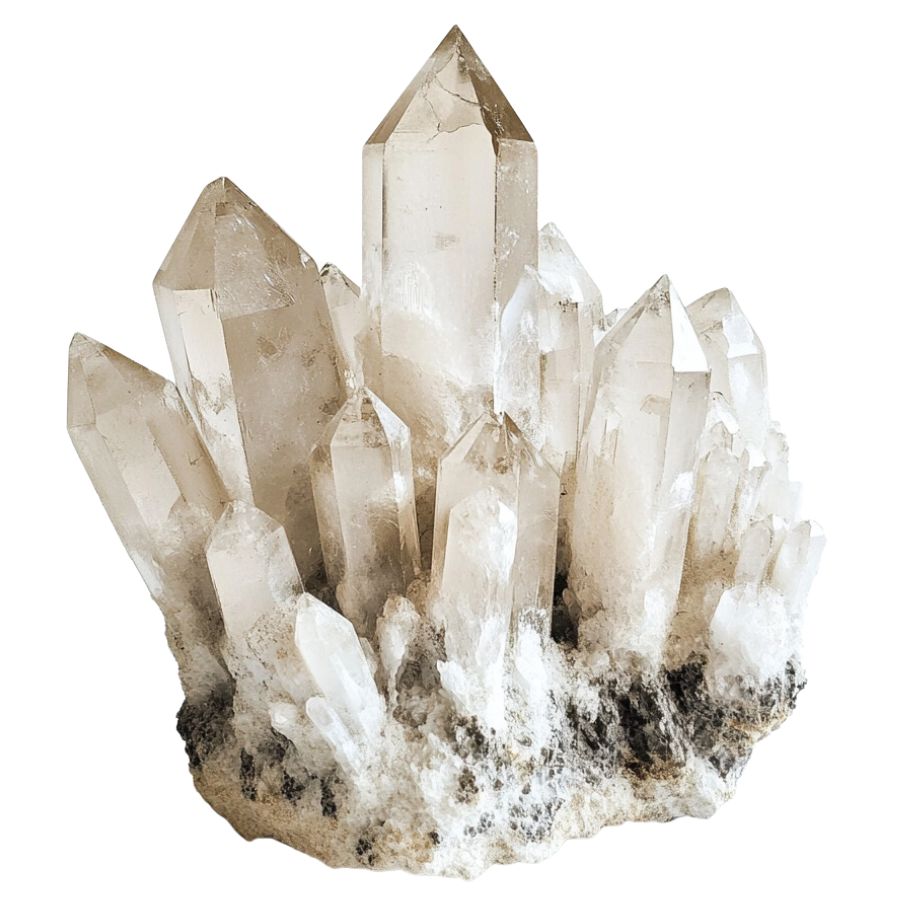
Quartz is among the most common minerals in the Earth’s crust and is prized for its durability and variety. It forms in a wide range of colors and types, from clear rock crystal to purple amethyst.
The mineral is notable for its hardness and durability, which contribute to its use in a variety of applications. Quartz is also popular in the manufacturing of electronics and watches due to its piezoelectric properties, which allow it to convert mechanical pressure into electrical energy.
Pyrite

Often mistaken for gold due to its metallic luster and pale brass-yellow hue, pyrite is known colloquially as “fool’s gold.” Its characteristic cube-shaped crystal formations look man-made but are actually completely naturally formed!
Pyrite also has historical importance in producing sulfur dioxide for sulfuric acid production.
Rhodochrosite
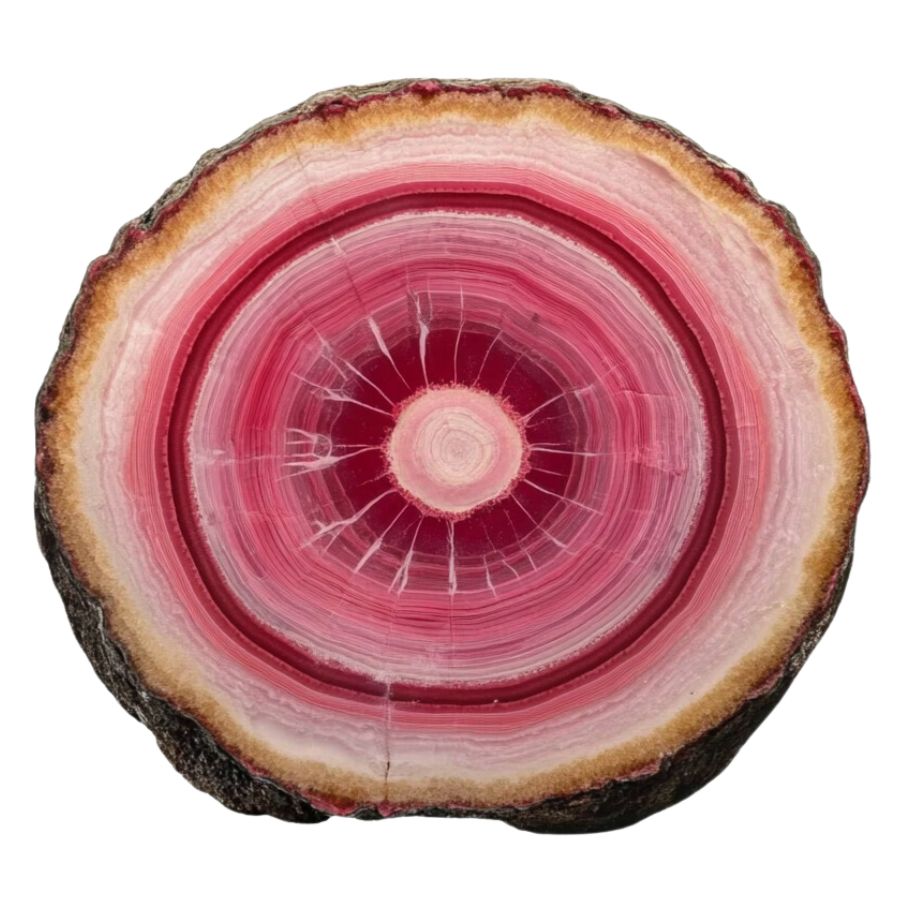
Rhodochrosite stands out with its rich pink and red hues, making it highly desirable as both a mineral specimen and a gemstone.
It typically forms in layered or stalactitic structures, with bands of colors that showcase how it grew over millions of years.
Beyond its beauty, rhodochrosite is significant as the main source of manganese, an essential element used in metal alloys.
Rhodonite

Appreciated for its deep pinks and reds, often complemented by black manganese oxide veins, rhodonite presents a dramatic appearance. It is typically found in metamorphic rocks and is used both as an ornamental stone and in jewelry.
In geology, rhodonite is significant for its role in metamorphic processes and its association with other manganese-rich minerals. It can be found in metamorphosed sedimentary rocks and is sometimes used as an indicator of the presence of manganese deposits.
Vivianite

Vivianite, an iron phosphate mineral, emerges in low-oxygen environments like peat bogs or iron-rich deposits. Its striking blue to green color, which can change to a lighter shade over time due to oxidation, makes it a distinctive mineral.
Found in various geological settings, vivianite provides clues about the local conditions and the presence of phosphate deposits.
The Types of Crystals We Found
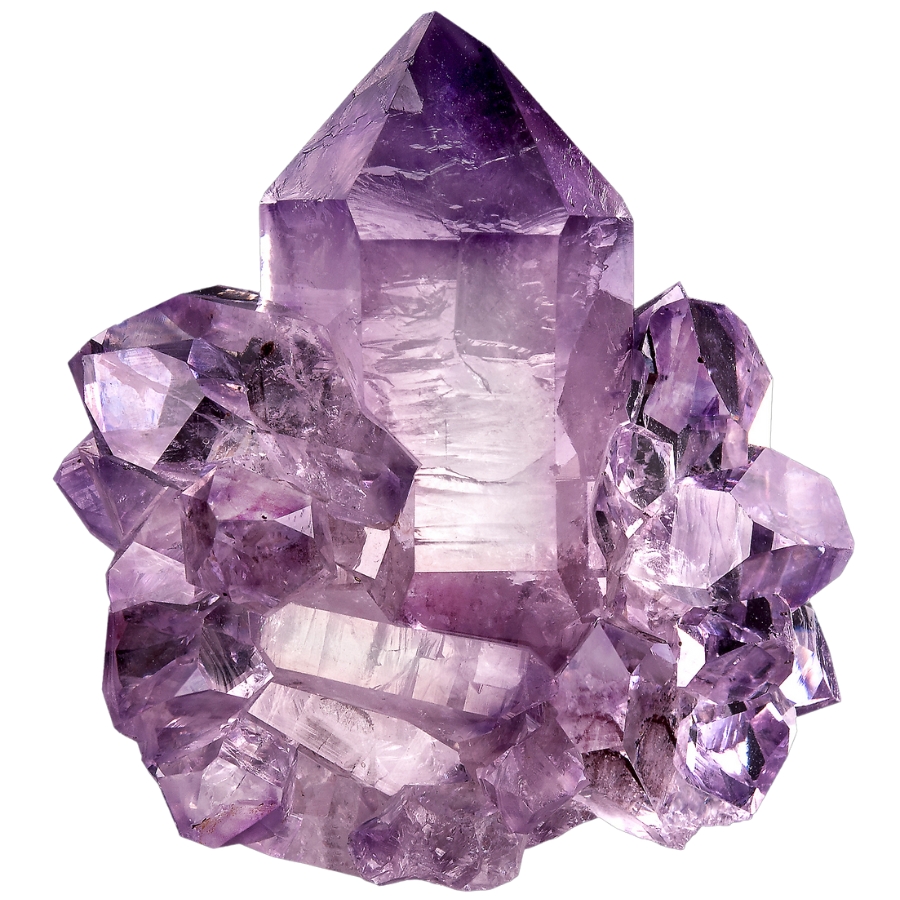
Iowa may not be known for having a lot of crystals, but the ones that can be found here are truly amazing. The beauty of these crystals lies not only in how they look, but also in how hard it is to find them.
There are still a lot of excellent rockhounding locations in the state, and these interesting and beautiful rocks make it even more fun to explore.
Rare crystals found in Iowa
- Amethyst
- Aragonite
- Carnelian
- Moonstone
- Sapphire
More common crystals found here
- Agate (Banded, Lake Superior, Moss, Oolitic, Sagenitic)
- Calcite
- Chalcedony
- Diamond
- Fossils
- Galena
- Hematite
- Jasper
- Onyx
- Pyrite
- Quartz
- Selenite
What rough crystals look like
When you’re out looking for crystals on your own it’s important to know what you’re looking for. This is what you need to look out for:
Look for exteriors like this

When you’re out searching for crystals in the wild, it’s essential to keep in mind that what you find won’t look like the polished stones you see in stores. One important tip is to consider what certain crystals look like in their raw, natural form.
Without the shine and smooth finish, crystals might appear rough, with jagged edges or earthy tones masking their true beauty. Understanding this can help you spot potential finds that might otherwise be overlooked.
Examine the crystal structure and shape

Crystals often form in specific geometric patterns that can be key to identifying them. For example, quartz is known for its hexagonal prisms, while halite typically forms cubic shapes.
By recognizing these distinct patterns, you can differentiate between various types of crystals and better understand what you’ve found.
Observe color

Some crystals are known for their distinct hues, like the deep purple of amethyst or the vibrant green of emerald. However, not all crystals will have strong colors; some may be clear or only slightly tinted.
Check the luster

Luster refers to how a crystal’s surface interacts with light. Some crystals might have a shiny, glassy luster, while others may appear metallic or dull. This characteristic can help you determine the type of crystal you’ve found.
However, it’s important to remember that luster isn’t always obvious right away. In some cases, a crystal’s true luster will only become apparent after it’s been cleaned or polished, so keep this in mind as you examine your finds.
Evaluate the transparency

Pay close attention to how much light passes through the crystal. Some crystals are completely clear, allowing light to pass through easily, while others may be opaque and block light entirely.
You might also encounter crystals with translucent edges but opaque centers. These variations in transparency can offer valuable clues about the type of crystal you’ve found, making it easier to identify and appreciate your discovery.
A Quick Request About Collecting
Always Confirm Access and Collection Rules!
Before heading out to any of the locations on our list you need to confirm access requirements and collection rules for both public and private locations directly with the location. We haven’t personally verified every location and the access requirements and collection rules often change without notice.
Many of the locations we mention will not allow collecting but are still great places for those who love to find beautiful rocks and minerals in the wild without keeping them. We also can’t guarantee you will find anything in these locations since they are constantly changing.
Always get updated information directly from the source ahead of time to ensure responsible rockhounding. If you want even more current options it’s always a good idea to contact local rock and mineral clubs and groups
Tips on where to look
Having a better idea of where to look can greatly narrow down your search and increase your chances of finding crystals. By focusing on environments where crystals are likely to be exposed, you can spend less time searching and more time discovering.
Outcrops and Exposed Rock

Rocky outcrops are prime locations for finding crystals and minerals. Search along the edges of outcrops, particularly where erosion has worn away the surrounding soil, revealing the rock underneath.
Pay close attention to any visible cracks, crevices, or small cavities within the outcrop, as these are often where crystals develop and can be extracted with minimal effort.
Stream Beds and Gravel Deposits

Stream beds are dynamic environments where water flow constantly shapes the landscape. Over time, water can erode rocks upstream, breaking them down and carrying mineral fragments, including crystals, downstream.
When searching in these areas, look for spots where the current has slowed, such as bends in the stream or areas behind large rocks, as these are prime locations for deposits.
Quarries and Mines

Quarries and mines are excellent places to search for crystals because they expose deep layers of rock that would otherwise be hidden beneath the surface. These sites often contain a variety of minerals and crystals that have been brought to the surface during excavation.
Pay attention to tailings piles, where waste rock is discarded, as they often contain overlooked or broken crystals. Always prioritize safety when exploring these areas and ensure that you have permission to search.
Road Cuts and Construction Sites

As roads are cut through hillsides or construction projects dig deep foundations, layers of rock and soil that have been undisturbed for millions of years are suddenly exposed.
Look for freshly exposed rock faces, especially where blasting has occurred, as this can create fissures or expose pockets filled with crystals. Be cautious around active construction sites, and always seek permission before exploring.
Mountainous Areas

In mountainous regions, erosion caused by wind, rain, and ice can wear away the softer rock, exposing harder crystals that have formed within. Focus on weathered and broken rock formations.
Look for scree slopes, where loose rock has accumulated at the base of cliffs. Additionally, areas near fault lines or volcanic vents are particularly promising, as they often have a higher concentration of minerals.
DON'T MISS OUT ON ANY GREAT FINDS!
While you're out searching for Crystals you're going to find A LOT of other interesting rocks and minerals along the way. The last thing you want to do is toss out something really interesting or valuable. It can be easy to misidentify things without a little guidance.
We've put together a fantastic field guide that makes identifying 140 of the most interesting and valuable rocks and minerals you will find REALLY EASY. It's simple to use, really durable, and will allow you to identify just about any rock and mineral you come across. Make sure you bring it along on your hunt!
The Mining Laws And Regulations You Should Know
Our state has set crystal mining laws, and as long as you comply with them, you can legally mine here. Check out the Iowa Department of Natural Resources to familiarize yourself with these laws related to exploring our state for crystals.
Ensure you are also aware and compliant with existing rules and regulations to protect our environment and biodiversity. Taking home our crystal finds shouldn’t be our only goal, but to also help maintain crystal mining as a sustainable activity for other rockhounds.
- The extensive local experience and understanding of our team
- Input from multiple local crystal hunters and crystal collecting groups
- The accessibility of the crystal mining locations
- Safety and potential hazards when collecting
- Private and public locations
- A desire to include locations for both experienced crystal hunters and those who are just starting out
Using these weights we think we’ve put together the best list out there for those who love finding new crystals for our collections!
The Best Locations For Crystal Mining in Iowa

We had the best time exploring the following fine spots, and we think you’ll have great success finding crystals in these places, too.
Always Confirm Access and Collection Rules!
Before heading out to any of the locations on our list you need to confirm access requirements and collection rules for both public and private locations directly with the location. We haven’t personally verified every location and the access requirements and collection rules often change without notice.
Many of the locations we mention will not allow collecting but are still great places for those who love to find beautiful rocks and minerals in the wild without keeping them. We also can’t guarantee you will find anything in these locations since they are constantly changing.
Always get updated information directly from the source ahead of time to ensure responsible rockhounding. If you want even more current options it’s always a good idea to contact local rock and mineral clubs and groups
Cedar River

The Cedar River is an important natural resource with a long history and a diverse ecosystem. It flows for 338 miles before joining the Iowa River.
Historically, the river was very important to the growth of local communities because it was a way for early settlers and Native American tribes to travel and trade.
Its banks and riverbed are made up of sedimentary rocks, mostly limestone, which are good for geodes to form. When you break these sphere-shaped rocks open, you can see beautiful crystalline insides, mostly made of quartz and calcite. The erosion of the river exposes these geodes, making them easy for collectors to get to.
The riverbanks are home to a wide range of plants and animals, making it a great place for geology and nature lovers alike.
Where we found crystals at Cedar River
The area around the Cedar River has a history of volcanic activity, which has helped the variety and abundance of crystals in the area.
The river’s constant flow also exposes and polishes different minerals, making it possible to find unique and beautiful crystal specimens.
Bell’s Mill Park

3100 Bells Mill Rd Stratford, IA 50249
Bell’s Mills Park is a hidden gem in the state’s scenic landscape. It has a rich tapestry of history and natural beauty. The park is named after a gristmill that the Bell family owned in the early 1800s.
It has remnants of the mill and the community that once thrived around it, which gives the park a layer of mystery and charm. It’s also among the best places to find Iowa gems.
The area around the park is known for its limestone formations, which are a good sign of possible crystal deposits. This limestone is part of the state’s natural makeup, comprised of sedimentary rock layers that formed over millions of years.
Where we found crystals at Bell’s Mill Park
You can find amazing samples of black Calcite cones through the outcrops and veins of Bell’s Mill Park.
Being close to water sources in the park, like streams and riverbeds, makes it more likely to find well-formed crystals. The steady flow of water helps to find and move these geodes, often polishing them.
DON'T MISS OUT ON ANY GREAT FINDS!
While you're out searching for Crystals you're going to find A LOT of other interesting rocks and minerals along the way. The last thing you want to do is toss out something really interesting or valuable. It can be easy to misidentify things without a little guidance.
We've put together a fantastic field guide that makes identifying 140 of the most interesting and valuable rocks and minerals you will find REALLY EASY. It's simple to use, really durable, and will allow you to identify just about any rock and mineral you come across. Make sure you bring it along on your hunt!
Muscatine

Muscatine County, IA
According to history, Muscatine started as a trading post in the 1830s and quickly grew into a thriving community. In the 1800s, it was known as the world’s largest pearl button manufacturer because of the large number of mussel shells in the river. This historical legacy gives the city its personality.
Muscatine’s location on the Mississippi River makes it a great place for crystal lovers. The river, a natural system that is always changing, has shaped the land over thousands of years, creating many mineral deposits.
The area is famous for its geodes in the sedimentary rock formations along the riverbanks. The erosion caused by the Mississippi River is a big part of how these geodes were found and made easier for enthusiasts to get to.
Where we found crystals at Muscatine
We highly recommend exploring the area gravels to south of Muscatine. Here, you’ll find samples of Agate (Lake Superior, Moss, Sagenitic), Chalcedony, and Quartz, among other crystals. Know more about how much crystals are worth in this article.
Bellevue
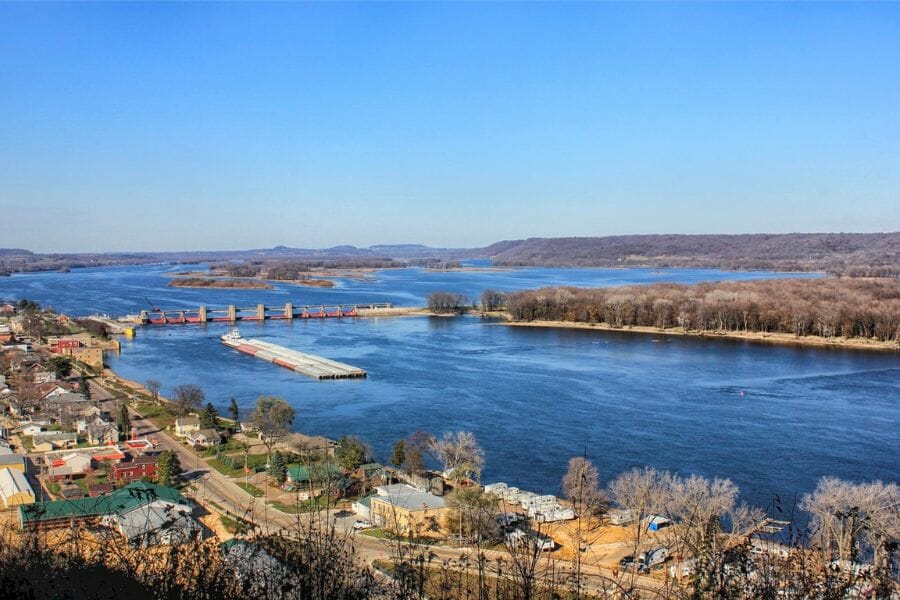
Jackson County, IA
Bellevue is a cute and beautiful town with a lot of history. It was founded in the early 1800s and quickly grew into a busy river town that was important for trade and transportation in the area. Its historic buildings and charming riverfront give Bellevue a unique and welcoming personality.
Notably, the area has a lot of sedimentary rocks, such as limestone, that are good for geode formation. Because the river is always moving, it helps to expose these geodes, making them easier for crystal hunters to get to.
With its beautiful riverfront and chance to find geological gems, Bellevue is a unique mix of the two.
Where we found crystals in Bellevue
Explore the Mississippi River gravels to find stunning specimens of Agate (Lake Superior, Moss), Carnelian, Moonstone, and Jasper crystals, among plenty other types.
Orient

Adair County, IA
The small, peaceful town of Orient has a rich history that returns to farming in the Midwest. It was founded in the late 1800s, and its history is linked to the growth of farming and rural community life in the state. This quaint town, with its friendly people and beautiful scenery, captures the simplicity and charm of rural America.
Orient’s geology makes it stand out as a possible hotspot. The town is in a place where the geology is suitable for the formation of quartz crystals and other mineral treasures.
The soil and rocks beneath it, which include layers of sedimentary rocks like shale and limestone, have a greater impact on Orient’s crystal formations than places where rivers are the main feature.
Orient is a great place to experience both the natural beauty and the cultural heart of the Midwest.
Where we found crystals at Orient
This area is particularly known for having the most fantastic samples of Agate and Quartz. If you’re here, we recommend exploring the area 5 miles to northeast.
Dubuque
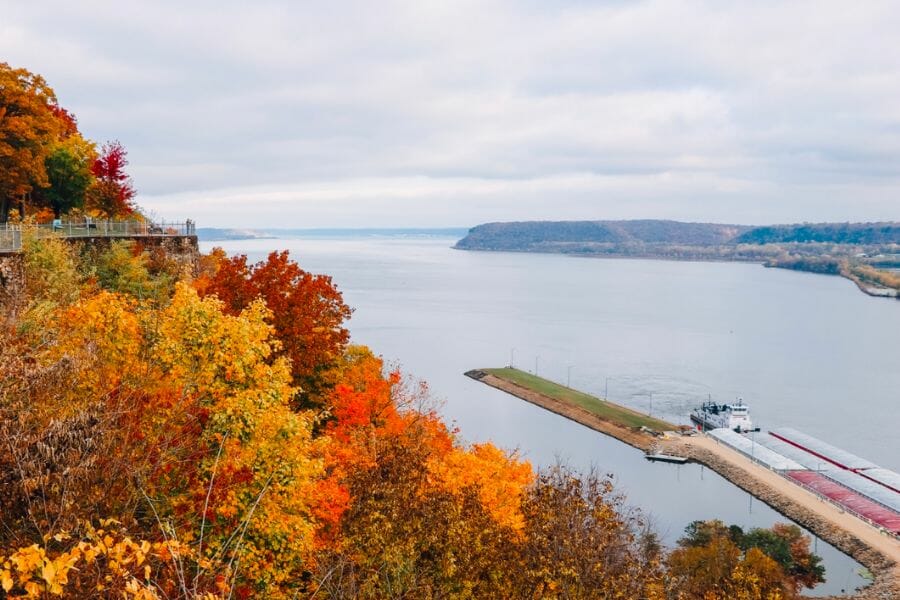
Dubuque County, IA
Dubuque has a rich history and culture along the bluffs of the Mississippi River. It was founded in 1833 and named after a French-Canadian explorer, Julien Dubuque.
This lively city has changed a lot since its early days from a hub for lead mining and fur trading to a modern center for the arts, education, and industry. The historic buildings and the revitalized riverfront show how the city has changed.
A big reason why crystal lovers like Dubuque is its location. The city is surrounded by limestone-rich areas that are part of the Driftless Zone and were not flattened by glaciers during the last ice age. This unique geological history has caused many minerals, especially geodes, to form.
Furthermore, the karst landscape of the area, which includes sinkholes and caves, makes it a perfect place for crystal growth.
Where we found crystals at Dubuque
Dubuque’s river gravels contain the most crystals here, including Agate (Lake Superior, Moss, Oolitic), Moonstone, and Jasper crystals, so we suggest exploring here first.
My Other Favorite Places For Crystal Hunting
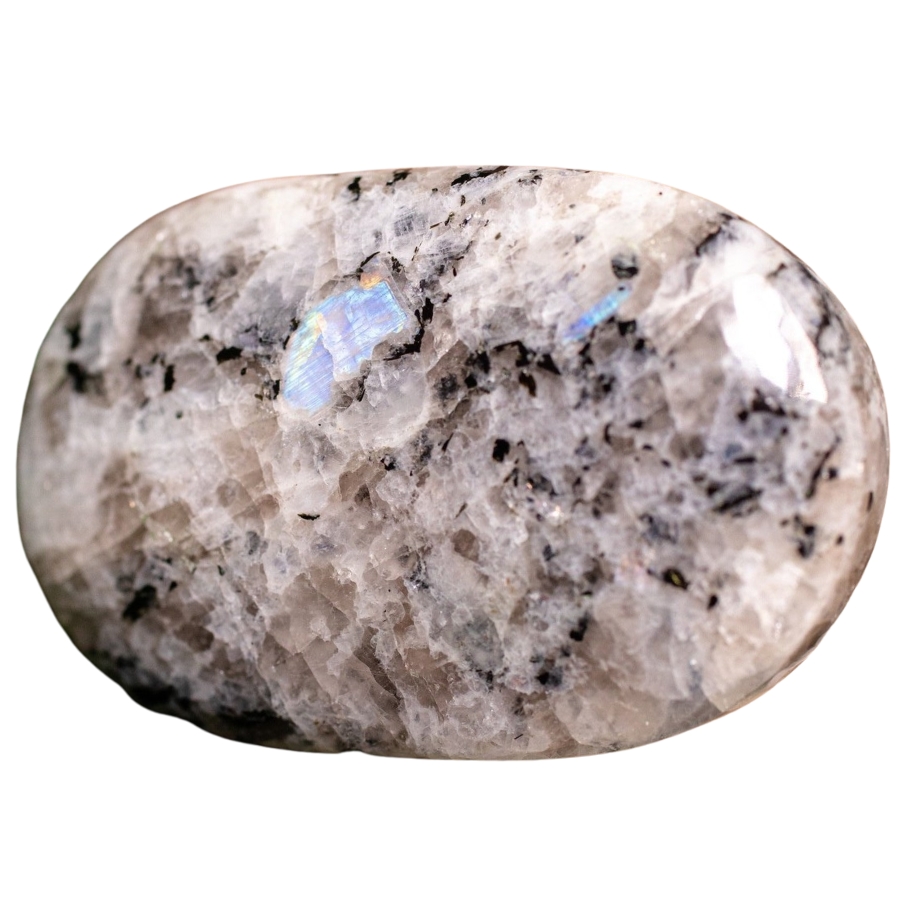
Despite its fairly limited crystal reserves, the state still has a lot more fine spots where you can find crystals. And since our state abounds in geodes, you can expect that the places we’ll share below are also some of the best sites to find Iowa geodes.
Where you can find crystals for free
If you aim to find and take home crystals without spending much, the following locations offer the best crystal reserves in our state without requiring any fees for searching through them.
| County | Location |
| Adair | Eastward at base of hills just south of Thompson River |
| Butler | Gravel pit of Shell Rock |
| Clayton | Guttenberg area |
| Clinton | At River Drive and Fourth Street in the Block Company gravel operation |
| Dallas | Mouth of branch at Raccoon River |
| Des Moines | Burlington area gravel-dredging operations and gravel pits |
| Dickinson | Shoreline of West Okoboji Lake |
| Fayette | County wide especially in streams |
| Henry | Mount Pleasant area |
| Keokuk | Keswick area quarry |
| Linn | Cedar Rapids area gravel pits |
| Mitchell | Osage area |
| Scott | Davenport area gravel pits |
| Story | Upstream on both sides of Indian Creek |
| Washington | At the Kaser Construction Company quarry |
Other great places to dig for crystals
If you’re willing to spend a few bucks to find the crystals you’re aiming for, here are the sites that require some fee. Take note that this fee may change depending on season (or they can free sometimes!), so call the place you’re targeting to visit first before heading out.
| County | Location |
| Allamakee | New Albin area mines |
| Appanoose | In coal mine dumps |
| Jasper | Area mines in Monroe |
| Mahaska | Oskaloosa area coal mine dumps |
| Marion | At the Pershing Mine dump |
| Monroe | Albia, Brompton, Foster, Lovilia, Melrose, and Tyrone area coal mine dumps |
| Polk | Des Moines area strip coal mines |
The Best Crystal Shops The Area

If you’re looking for a less strenuous but successful way to find and bring home crystals, we recommend visiting the local crystal shops here. Below is a list of the best ones we have:
- Dories Crystals and Things – 101 Pearl St, Council Bluffs, IA 51503
- PrismScape Gems & Healing Center – 1700 S 1st Ave #11c, Iowa City, IA 52240
- Chakra Khan Crystals – 1800 Grand Ave, West Des Moines, IA 50265
- Little Rock and Gem Shop – 3002 N Brady St, Davenport, IA 52803
- Mood Crystals and Stones – 918 Broadway St #2, Emmetsburg, IA 50536
- Realive Metaphysical Shop – 3800 Wilson Ave SW, Cedar Rapids, IA 52404
- Studded With Love – 1122 W 4th St, Waterloo, IA 50702
- Ema’s Elegance Specialty Stones – 811 Story St, Boone, IA 50036
- Ancient Ways – 2420 University Ave, Des Moines, IA 50311
- The Moon Awakening – 908 SE 6th St, Des Moines, IA 50309
Additional places to find crystals in nearby states
If you’ve already tried all of our recommendations above or are planning a trip out of the state, you should check out our guides for neighboring states:
- Crystals in Minnesota
- Crystals in Wisconsin
- Crystals in Illinois
- Crystals in Missouri
- Crystals in Nebraska
- Crystals in South Dakota
If you have any recommendations we haven’t covered, please leave them in the comments below!


